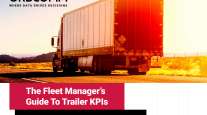Opinion: Three Areas Where Fleets Could Fail
By Joe White
CEO
CostDown Consulting
This Opinion piece appears in the March 11 print edition of Transport Topics. Click here to subscribe today.
As a consultant, I have analyzed the operations of many trucking companies. Interestingly, regardless of company size or type of operation, trucking companies share common failure points — activities or programs they lack that have a negative effect on profitability. The following is an overview of three of the most common failure points.
• Retention — Failure to “recruit” existing (yes, existing) drivers.
Recruiting is the process of communicating what is called the “employment promise” to job candidates. In the trucking industry, the employment promise provides specific information regarding wages, benefits, home time, truck assignments (company driver), truck pay (owner-operator) and working conditions at the hiring company.
Employment promises by design attract driver candidates through communication of the unique benefits of working at a particular company. Once drivers are hired, they obviously are no longer job candidates and, therefore, no longer receive communication of their new employer’s employment promise.
Those drivers do, however, continue to receive employment promises — lots of them — from their employer’s competitors. Competing trucking companies constantly broadcast their unique employment promise through radio spots, newspaper ads, websites, truck stops and their own drivers, motivated by referral bonuses.
Retention strategies need to recognize that not only are your employees a competitor’s best source of experienced, qualified drivers, they are also your best source of experienced, qualified drivers.
Trucking companies need to communicate frequently and reinforce the value of their employment promise to existing drivers for two reasons: The first is that the employment promise is constantly evolving as a tightening labor market forces higher wages and other hiring and working incentives. The second is that retention success depends on your drivers completely understanding and appreciating the job benefits provided by their current employer as they receive and process a constant barrage of employment promises from potential future employers.
• Training — Failure to train field managers in cost performance.
Field managers — that is, terminal managers and driver managers — influence profitability more than any other employee group in trucking. Each of them makes literally hundreds of decisions a week that influence cost performance.
Unfortunately, many field managers do not understand how to improve cost performance. Here’s a simple test to determine how effectively your field team manages costs. Ask them this question: “What is our variable cost per mile?” Map the range of answers, compare that range to your actual variable cost per mile, and you will have a fair assessment of how effectively your field managers use cost calculations when making decisions for assigned drivers and trucks.
Understanding cost is critical to profitability, especially in trucking. How can field managers make financially sound decisions about deadheading drivers, accepting loads, authorizing delays or deciding which direction to send a driver if they don’t know how to calculate the associated cost?
In addition to variable cost training, field managers should receive training on the basic relationships between cost, revenue and profit. Here is an abbreviated example:
In a 5% net profit business, it takes $20 of revenue to generate $1 of profit. Therefore, the relationship between revenue and profit is 20:1. However, if you reduce cost by $1, profit increases by $1. Therefore, the relationship between cost and profit is 1:1.
Next, demonstrate how to use these relationships by providing an example your field managers can relate to: A driver manager’s idling-reduction coaching and monitoring activities reduced total fuel costs for her assigned drivers by $5,500 per year. What are the profit and revenue effects of her actions?
The profit effect: $5,500 was added to the bottom line (profit) because eliminating a dollar of cost adds a dollar of profit.
The revenue effect: Since the relationship of revenue to profit is 20:1 it would have taken $110,000 of additional revenue (20 x $5,500) to generate an equal amount of profit.
• Performance — Failure to provide support for performance goals.
An effective performance-management program combines performance goals, standard operating procedures (SOPs) and financial incentives to improve employee performance. Most trucking companies assign performance goals to their employees, but far fewer provide the defined SOPs and financial incentives required to support improved performance.
SOPs are the best activities to use when managing a specific performance area. Track the historical performance of six driver managers with the same performance goals, and you will discover that, individually, they excel at different goals. The top performer in each goal is most likely using the best activities to meet that goal.
Collect and publish the best activities from the top performer for each goal, and you will have SOPs that all driver managers should use to improve total company performance for all goals.
Financial incentives provide motivation that significantly increases employee effort levels and the potential for making assigned goals.
Since each goal represents an improvement over past performance, goal obtainment results in a savings that drops to the bottom line. (Remember: eliminating $1 of cost adds $1 of profit.)
The additional profitability generated by making a goal should be forecast and a portion set aside to self-fund financial incentives.
There are enough other common failure points shared by trucking companies to overflow the space allotted to this op-ed, but what’s important to include is that most — if not all — of trucking’s common failure points do not require large amounts of capital to fix. They simply require that a company improve the activities and programs they use and the training and support they provide their employees.
CostDown Consulting, Grayson, Ga., provides trucking companies with driver retention and cost-reduction analysis, programs and training.



